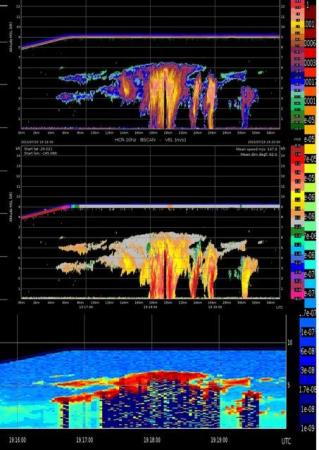Aug 10 2015
Nearly 40 years after taking his first aircraft measurements of clouds off the California coast, University of Miami Professor Bruce Albrecht has returned again this month equipped with new state-of-the-art technologies to understand the effects of low-lying clouds on global climate.
 Radar and lidar imagery from the flight back to California. These datasets, unprecedented for this region, will contribute to developing a comprehensive understanding of how aerosols and precipitation modify the clouds and their coverage of the underlying ocean, distinct from meteorology. Credit: NCAR
Radar and lidar imagery from the flight back to California. These datasets, unprecedented for this region, will contribute to developing a comprehensive understanding of how aerosols and precipitation modify the clouds and their coverage of the underlying ocean, distinct from meteorology. Credit: NCAR
"These low clouds are extremely important to the climate system because they reflect sunlight back to space, which provides the primary cooling of our planet," said Bruce Albrecht, professor of atmospheric sciences at the UM Rosenstiel School of Marine and Atmospheric Science. "The processes through which cloud coverage will change as our planet warms remains largely uncertain in climate predictions."
The first of 14-projected research flight aboard the state-of-the-art National Science Foundation (NSF) Gulfstream V research aircraft took off on July 1 from Sacramento, California to sample the trade wind-driven clouds as they move across the Pacific Ocean to Hawaii. During the nearly two month-long experiment, the research team is studying the process by which these low clouds - stratocumulus and cumulus - change shape as they move with the prevailing trade winds. The project is unique in that the same cloud areas sampled by the research aircraft on the flights to Hawaii are re-sampled two days later when the aircraft returns to California, allowing the evolution of the cloud systems to be studied.
Stratocumulus and cumulus clouds both reflect solar radiation back into space, but in differing amounts. The process by which stratocumulus transitions into cumulus depends on many factors, not all well understood. To gather a more detailed picture of the clouds, Albrecht and his research team are sampling across a range of scales, from the fine particles called aerosols that "seed" the cloud droplets, to the large raindrops that deplete the clouds, and the larger thermodynamic environment to which the clouds are responding. Learning more about the finer details of these clouds is necessary to estimate the solar energy that eventually reaches Earth.
The research aircraft is equipped with new technology, such as an airborne Doppler cloud radar and an aerosol lidar, to provide the researchers with a better understanding of the cloud structure, aerosols, and precipitation, which will provide them with significant new insights on the role of these clouds on the global climate system.
"Our preliminary data are already revealing that aerosol-depleted environments are much more common than previously thought, changing textbook ideas on the low cloud lifecycle," said Paquita Zuidema, professor of atmospheric sciences at the UM Rosenstiel School and co-investigator of the study.
"Due to improvements in long-distance research flight operations and technology, my dream of forty years has come true," said Albrecht.
Source: http://www.rsmas.miami.edu/